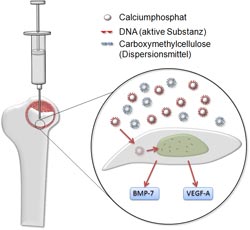Chemists at the UDE develop a nanopaste for the repair of bone defects

A graphic showing the mode of action of the paste photo © UDE<br>
Unfortunately, these procedures do not always have the desired effect. Now Prof. Dr. Matthias Epple and his research team at the University of Duisburg-Essen (UDE) have developed a nanoparticle paste which can be injected into the defect and results in improved healing.
The trick: the researchers have combined synthetic calcium phosphate with DNA.
Now a professor for inorganic chemistry, Matthias Epple was attracted to the interface between biology and medical science. “We have been investigating the impact of mineral tissue such as teeth, bone and sea shells for many years and are now using the knowledge we have gained to produce new biomaterials.” To achieve this he has collaborated closely with medical scientists and his current project – carried out with three of his doctoral students – was no exception.
“The repair of bone defects presents a real challenge for surgeons,” he relates. “When possible they collect the patient’s own bone from various locations, such as the iliac crest, and implant it where needed to fill defects.” The researcher explained that since there is only a limited amount of surplus bone material in the body, synthetic materials are now being used. “Calcium phosphate is a natural choice here since it is an inorganic mineral found in bones in the form of nanocrystals. It is a material familiar to the body, which makes it a suitable carrier.” He added that the calcium and phosphate ions lead to improved new bone formation.
However, the use of synthetic materials creates a host of new problems: the bones heal more slowly, the risk of infection is greater and the mechanical stability is not ideal. Epple’s team has now created a bone repair paste by coating synthetic nanocrystals of calcium phosphate with nucleic acids – in other words, with DNA. The professor explains what happens when this paste is injected into a bone defect: “The nanoparticles are taken up by cells. The calcium phosphate dissolves and the DNA that is released stimulates the formation of two proteins important for healing: BMP-7, which stimulates bone formation, and VEGF-A, which is responsible for the creation of new blood vessels. As a result, the new bone is supplied with valuable nutrients.”
The UDE researchers expect that the paste will have a long-lasting effect since the nanoparticles are released successively and thus continuously stimulate the surrounding cells. They have demonstrated that the paste works in three different cell types. Further tests now have to be conducted. Epple and his co-researchers hope that “our development will be used several years from now in the field of traumatology and in the treatment of osteoporosis.”
The results of this research were recently published in the international journal RSC Advances:
DOI: http://dx.doi.org/10.1039/C3RA23450A
For additional information, contact:
Prof. Dr. Matthias Epple, Tel. +49 (0) 201 183 2413, matthias.epple@uni-due.de
Responsible for Press Release: Ulrike Bohnsack, Tel. +49 (0) 203 379 2429
Translation: Shawn Christoph
Media Contact
More Information:
http://www.uni-due.deAll latest news from the category: Life Sciences and Chemistry
Articles and reports from the Life Sciences and chemistry area deal with applied and basic research into modern biology, chemistry and human medicine.
Valuable information can be found on a range of life sciences fields including bacteriology, biochemistry, bionics, bioinformatics, biophysics, biotechnology, genetics, geobotany, human biology, marine biology, microbiology, molecular biology, cellular biology, zoology, bioinorganic chemistry, microchemistry and environmental chemistry.
Newest articles

“Nanostitches” enable lighter and tougher composite materials
In research that may lead to next-generation airplanes and spacecraft, MIT engineers used carbon nanotubes to prevent cracking in multilayered composites. To save on fuel and reduce aircraft emissions, engineers…

Trash to treasure
Researchers turn metal waste into catalyst for hydrogen. Scientists have found a way to transform metal waste into a highly efficient catalyst to make hydrogen from water, a discovery that…

Real-time detection of infectious disease viruses
… by searching for molecular fingerprinting. A research team consisting of Professor Kyoung-Duck Park and Taeyoung Moon and Huitae Joo, PhD candidates, from the Department of Physics at Pohang University…





















